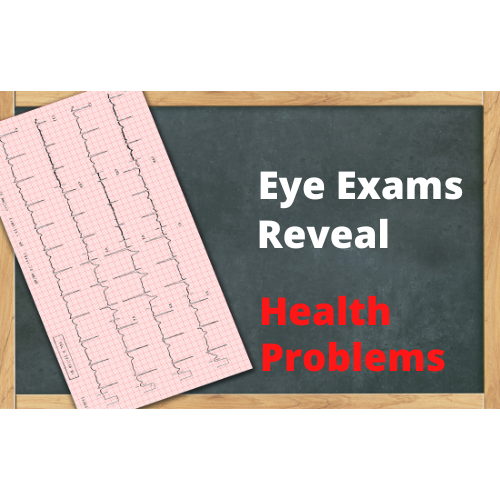Eye Exams Detect Health Problems


Systemic health problems can often be detected via eye exams.
Getting regular eye exams is a good way to stay on top of your health. That’s because a comprehensive eye exam is an excellent way to detect at least 20 health problems in their early stages when they are not yet detectable by other routine medical tests.
Your eyes are a window into your body’s health. A close inspection of your lenses, retina, and optic nerve can reveal many systemic disorders even before their symptoms become evident. Blood vessels and nerve tissue that run all the way to the brain are visible in a dilated eye exam.
Here is a list of a few of the health problems or disorders that an eye exam can detect:
High Blood Pressure
Unusual bends, kinks, or bleeding from blood vessels in the back of the eye can signal high blood pressure.
High Cholesterol
A yellow or blue ring around the cornea may be a sign of high cholesterol in persons younger than 40. Deposits in the blood vessels of the retina can also indicate elevated cholesterol. Detecting and treating high cholesterol early can prevent a life-threatening stoke.
Sickle Cell Anemia
The sickle cell mutation causes red blood cells to deform into a sickle (crescent) shape. The deformed blood cells cannot travel through the blood vessels as well as normal-shaped red blood cells. These malformed blood cells can be detected during the examination of the retina.
Rheumatoid Arthritis
This chronic inflammatory disease affects the joints but can also show up in the eyes. Dry eye is the most common eye symptom of rheumatoid arthritis. It can also show up as inflammation of the sclera (the whit outer layer of the eye). This is because inflammatory conditions affect collagen which is the main component of connective tissue, and the sclera is composed mostly of collagen.
Brain Tumors
Brain tumors are not always life-threatening. About 80,00 people are diagnosed with a brain tumor every year and many of them are non-malignant. But even when a brain tumor is not malignant it can still cause problems. An eye exam can reveal if you might have a brain tumor that is putting pressure on your eyes.
Vascular Disease
Vascular disease affects the blood vessels that carry oxygen and nutrients throughout the body and remove waste from the tissues. Common vascular problems happen because plaque (fat and cholesterol deposits) slow down or block blood flow inside the arteries or veins. The clotting and bleeding disorders caused by vascular disease can cause visible bleeding in and around the eye.
What Next?
Whenever an eye exam reveals a possible health problem, your eye care professional will recommend that you follow-up by scheduling an appointment with your primary care physician or a specialist who can order further testing and begin treatment.
The American Academy of Ophthalmology recommends that all adults have a complete eye examination at the age of 40 because this is when early signs of disease or changes in vision may first appear.
Gregory Scimeca, M.D.
Ophthalmologist and Medical Director
The Eye Professionals
Our Locations
